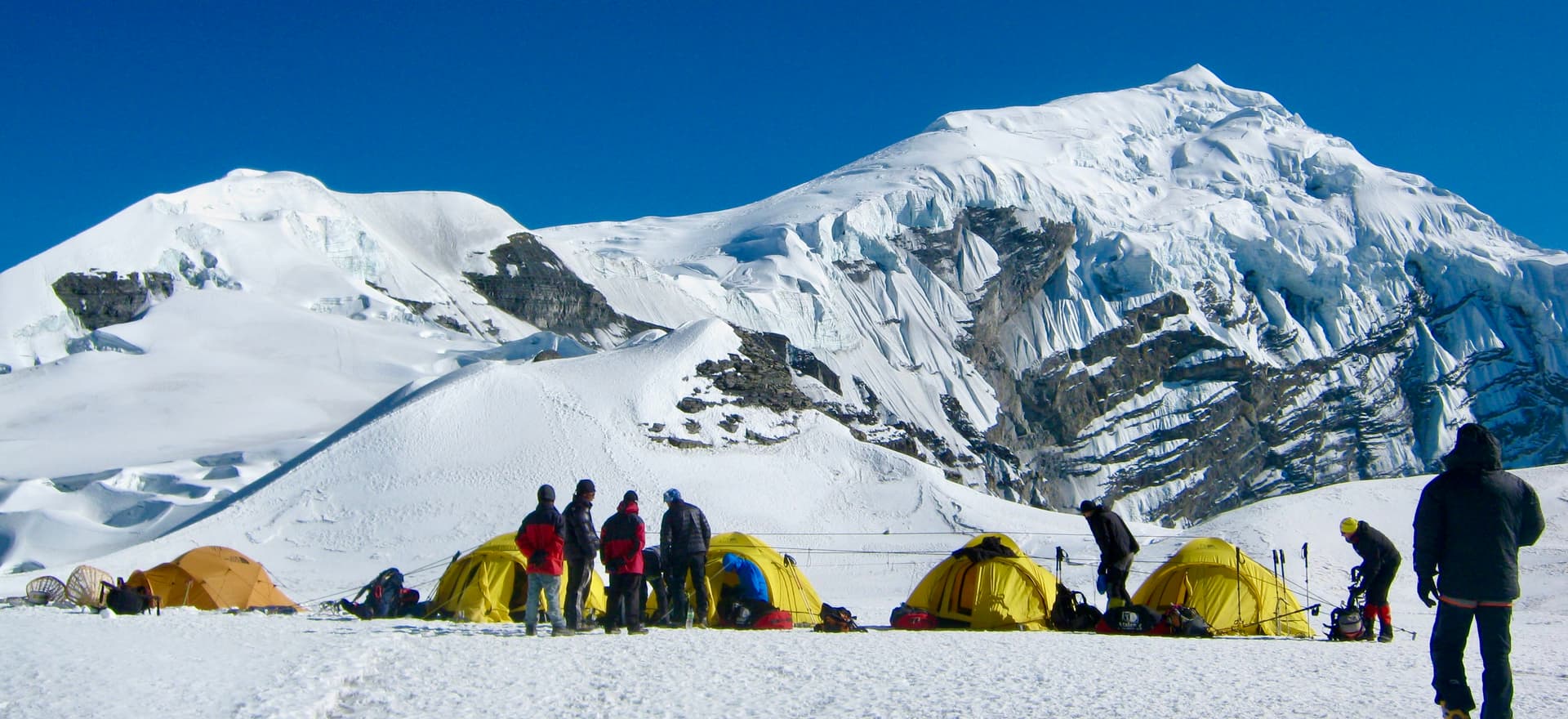Nepal, a land synonymous with breathtaking mountain landscapes, offers a myriad of climbing opportunities, especially for those new to the world of mountaineering. For beginners eager to experience the thrill of summiting a peak without the daunting challenges of higher altitudes and technical climbs, certain mountains stand out as ideal starting points. Luxury Holidays Nepal Pvt. Ltd. presents the Top 7 Easiest Mountains to Climb in Nepal for Beginners, a list carefully curated to suit novice climbers. This list includes the Mt Ama Dablam Expedition (6,812 m), the Island Peak Expedition (6,189 m), Mera Peak Climbing (6,476 m), Chulu West Peak Climbing (6,419 m), Pisang Peak Climbing (6,091 m), Singu Chuli Peak Climbing (6,501 m), and Lobuche Peak Climbing (6,119 m). Each of these mountains offers a unique climbing experience, blending the excitement of a Himalayan adventure with the safety and accessibility needed by beginners. With this guide, you can embark on a journey that not only satisfies your adventurous spirit but also respects your level of experience.
We pride ourselves on being the premier choice for adventurers seeking to embark on the Top 7 Easiest Mountains to Climb in Nepal for Beginners. Our unparalleled expertise in organizing expeditions to peaks like Mt Ama Dablam, Island Peak, Mera Peak, Chulu West Peak, Pisang Peak, Singu Chuli Peak, and Lobuche Peak sets us apart in the realm of Himalayan adventures. We understand the unique challenges and aspirations of beginner climbers, and our tailored expeditions are designed to offer a seamless and enriching experience. Our team of experienced guides, commitment to safety, and personalized approach ensure that each journey is not just a climb, but a life-changing adventure. Whether you're taking your first steps into mountaineering or looking to expand your climbing experience, Luxury Holidays Nepal is your trusted company in conquering the majestic peaks of Nepal, promising an adventure that's as safe as it is exhilarating.
Mt Ama Dablam Expedition (6,812 m)
Mt Ama Dablam, standing at an impressive 6,812 meters, is not just one of Nepal's most beautiful mountains, but it's also among the top choices for beginners venturing into Himalayan mountaineering. This expedition offers a mix of moderate climbing challenges and awe-inspiring scenery, making it an ideal start for novices in high-altitude climbing.
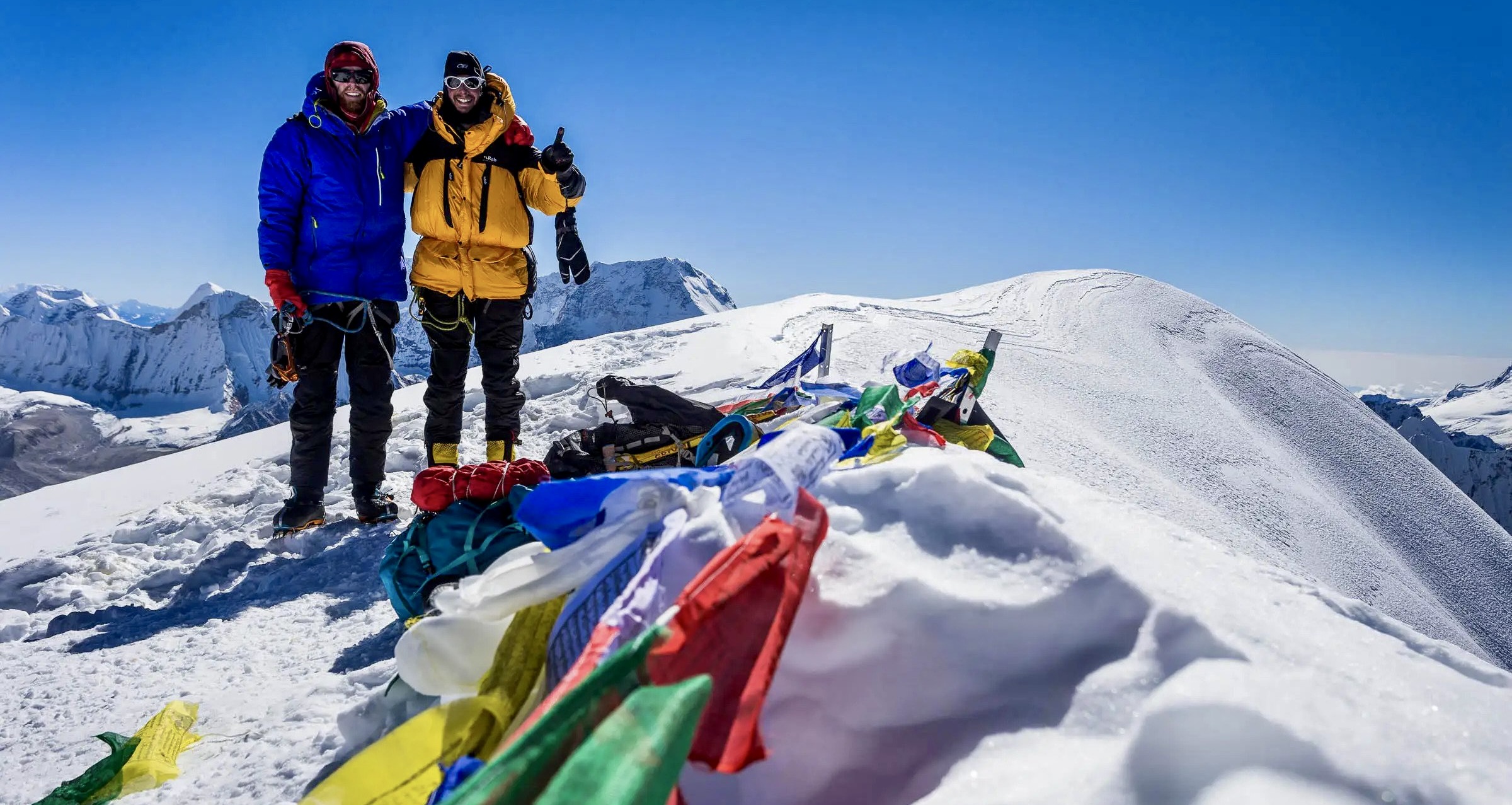
Key Features of Mt Ama Dablam Expedition
-
Iconic Shape and Beauty: Mt Ama Dablam is renowned for its distinctive pyramid shape, often described as one of the world's most beautiful mountain peaks. Its stunning appearance makes it a highly sought-after objective for climbers.
-
Non-Technical Climb: While the climb is challenging, it is less technical compared to other high-altitude expeditions. This makes it a suitable choice for beginners who have basic mountaineering skills and are in good physical condition.
-
Acclimatization and Safety: The route to Mt Ama Dablam includes ample opportunity for acclimatization, which is crucial for a successful and safe ascent. Safety is further ensured by the presence of experienced guides and well-established base camps.
-
Cultural Experience: The journey to Mt Ama Dablam passes through traditional Sherpa villages, like Namche Bazaar, offering climbers a chance to experience the rich local culture and hospitality of the Khumbu region.
-
Stunning Himalayan Views: Climbers are rewarded with breathtaking panoramic views of famous neighboring peaks, including Mt. Everest, Lhotse, and Makalu.
-
Base Camps and Route: The expedition involves setting up multiple base camps as climbers ascend, providing a comprehensive mountaineering experience. The standard route for the climb is via the South-West Ridge, which is both scenic and relatively accessible.
-
Skill Development: It’s an excellent opportunity for beginners to develop and refine their mountaineering skills, including using climbing equipment, understanding mountain weather, and experiencing high-altitude conditions.
Why Choose Mt Ama Dablam for Beginners
- Feasible Challenge: It strikes a balance between being a challenging climb and a feasible objective for those new to high-altitude expeditions.
- Comprehensive Climbing Experience: Offers an all-encompassing experience of Himalayan climbing, from technical aspects to dealing with altitude and harsh weather conditions.
- Scenic and Cultural Richness: The expedition is not just about climbing; it's also a journey through some of the most scenic landscapes and culturally rich regions in Nepal.
The Mt Ama Dablam Expedition is a perfect starting point for beginners aiming to step into the world of Himalayan mountaineering. It provides an adventurous yet manageable climb, filled with natural beauty and cultural experiences, under the expert guidance of Luxury Holidays Nepal Pvt. Ltd.
Island Peak Expedition (6,189 m)
Island Peak, also known as Imja Tse, stands at 6,189 meters and is one of the most popular choices for beginners in the Himalayas. This peak offers a perfect introduction to high-altitude climbing, combining an accessible ascent with magnificent views and a taste of technical mountaineering.

Key Features of Island Peak Expedition
-
Ideal for Beginners: Despite its elevation, Island Peak is considered one of the easier climbs in the Himalayas, making it a perfect choice for those new to mountaineering.
-
Scenic Trekking Route: The approach to Island Peak includes trekking through the famous Everest region, offering stunning views of the world's highest mountains and insight into the local Sherpa culture.
-
Manageable Technical Aspects: The climb includes some basic snow and ice climbing, providing a great introduction to these techniques without being overly technical.
-
Acclimatization and Safety: The route is carefully designed to allow proper acclimatization, minimizing the risk of altitude sickness. Safety is further ensured by experienced guides and well-planned expeditions.
-
Summit Views: From the top of Island Peak, climbers are rewarded with spectacular views of neighboring Himalayan giants, including Ama Dablam, and Makalu, and a distant view of Mt. Everest.
-
Base Camp and High Camp: The expedition involves setting up a base camp and a high camp, providing a complete mountaineering experience. This also helps climbers acclimate to high-altitude conditions.
-
Skill Development: Climbing Island Peak is an excellent opportunity for beginners to learn and practice mountaineering skills, including using crampons, and ice axes, and navigating glaciers.
Why Choose Island Peak for Beginners
- Accessibility and Feasibility: It is more accessible and less daunting than other high-altitude peaks, making it an ideal starting point.
- Combination of Trekking and Climbing: Offers a blend of trekking and climbing, perfect for those who want to experience both aspects of Himalayan adventures.
- Cultural Enrichment: The journey through the Khumbu region provides a deep dive into the rich culture and traditions of the Sherpa community.
The Island Peak Expedition is a fantastic choice for beginners, offering a taste of what it's like to climb in the Himalayas without the extreme challenges of higher and more technical peaks. It's a journey that combines physical challenge, stunning natural beauty, and cultural richness, expertly guided by Luxury Holidays Nepal Pvt. Ltd.
Mera Peak Climbing (6,476 m)
Mera Peak, standing at 6,476 meters, is a prime destination for those new to high-altitude climbing. It holds the distinction of being the highest trekking peak in Nepal, offering a manageable yet rewarding challenge for beginners. The climb to Mera Peak is more than just an ascent; it's an adventure through some of the most stunning landscapes in the Himalayas.
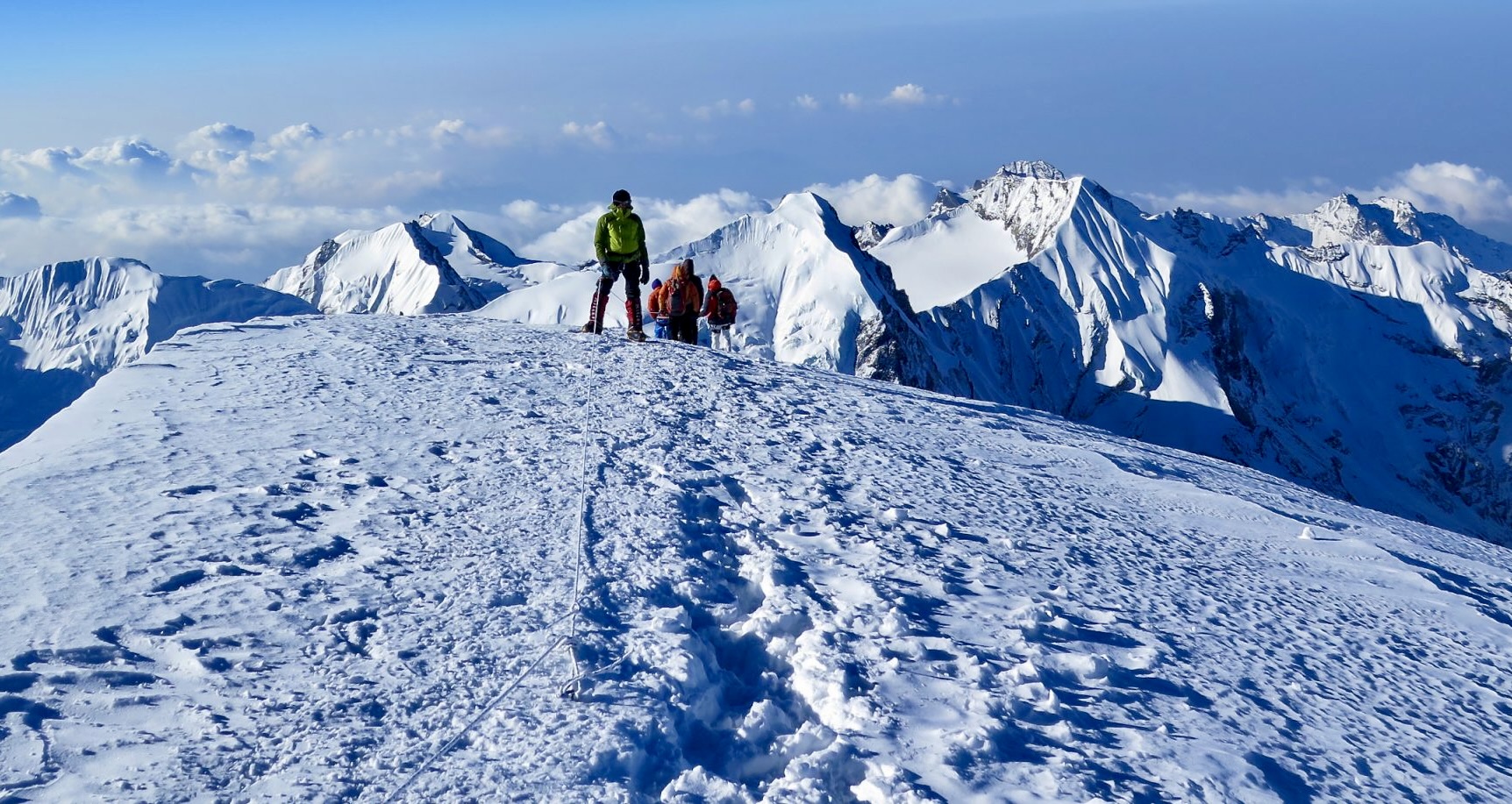
Chulu West Peak, rising to an elevation of 6,419 meters, is an excellent choice for beginners looking to delve into the world of Himalayan mountaineering. Situated in the Annapurna region, this peak offers a combination of accessible climbing and stunning natural beauty.
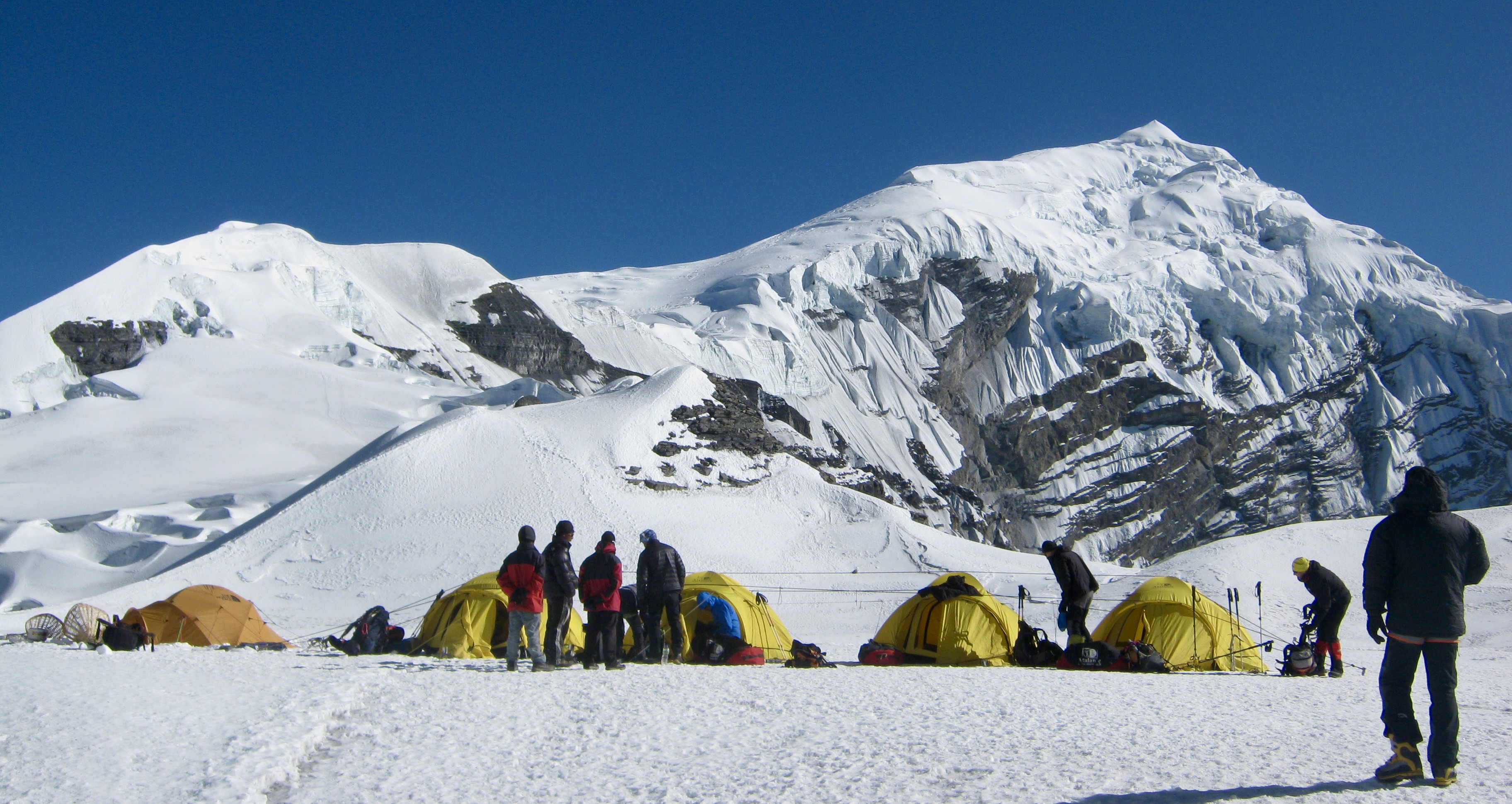
Key Features of Chulu West Peak Climbing
-
Moderate Climbing Challenge: Chulu West provides a moderate challenge, making it an appropriate choice for beginners who have a basic level of fitness and some mountaineering skills.
-
Stunning Annapurna Views: The climb offers spectacular views of the Annapurna range, including Annapurna I and Dhaulagiri, along with a host of other peaks, providing a truly rewarding experience.
-
Varied Terrain: The route to Chulu West encompasses diverse terrains, including trekking through forests and villages, as well as climbing on snow and ice. This variety offers a comprehensive introduction to different aspects of mountaineering.
-
Cultural Richness: The journey passes through traditional mountain communities, especially the Manang region, known for its unique culture and hospitality, adding a rich cultural dimension to the climbing experience.
-
Skill Development and Training: The expedition includes opportunities for climbers to learn and practice essential mountaineering skills, making it suitable for those looking to build their experience in a safe and controlled environment.
-
Safe and Structured Ascent: With well-planned acclimatization and a guided approach, the climb is structured to maximize safety and success rates for beginners.
-
Remote and Pristine Environment: Unlike more crowded peaks, Chulu West offers a more remote and untouched climbing experience, allowing climbers to enjoy the tranquility and pristine nature of the Himalayas.
Why Choose Chulu West Peak for Beginners
- Balanced Climbing Experience: It strikes a perfect balance between adventure and accessibility, offering a manageable challenge for novice climbers.
- Scenic Beauty and Isolation: The region's natural beauty is unmatched, and the relative isolation of the peak provides a more intimate experience with the Himalayas.
- Opportunity for Comprehensive Learning: The expedition is ideal for beginners looking to gain a broad range of mountaineering skills in a single climb.
Chulu West Peak Climbing is a fantastic entry point into Himalayan mountaineering for beginners. It combines the thrill of climbing, the beauty of the Annapurna region, and the opportunity for skill development, all under the expert guidance of Luxury Holidays Nepal Pvt. Ltd.
Pisang Peak Climbing (6,091 m)
Pisang Peak, standing at 6,091 meters in the Annapurna region, is a favored choice for beginners in mountaineering. Known for its relatively straightforward ascent and breathtaking views, Pisang Peak offers a fulfilling and manageable climbing experience for those new to high-altitude expeditions.
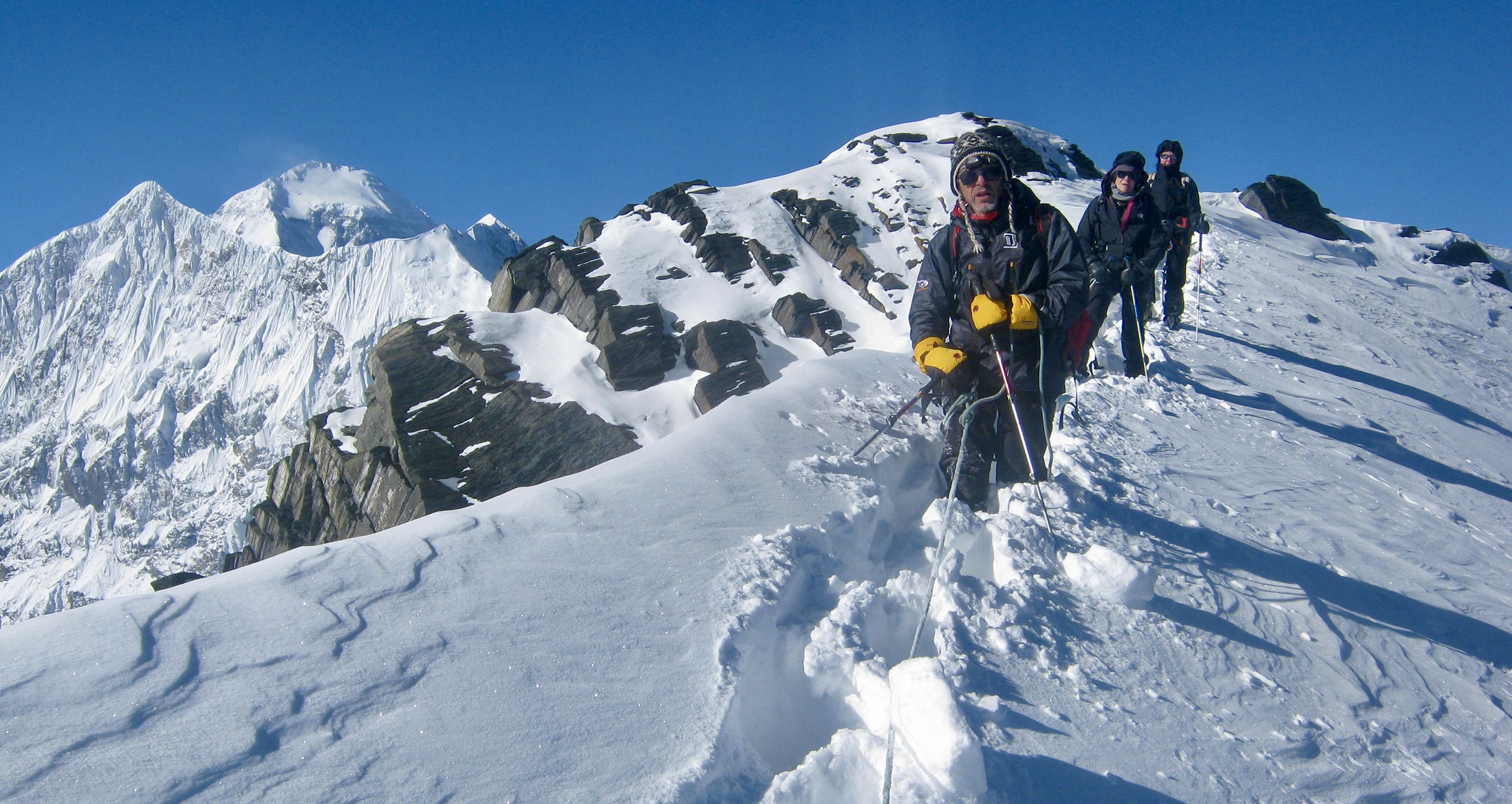
Key Features of Pisang Peak Climbing
-
Ideal Introduction to Mountaineering: Pisang Peak serves as an excellent introduction to Himalayan climbing, offering a manageable challenge for beginners.
-
Stunning Annapurna Circuit: The climb is part of the famous Annapurna Circuit trek, providing an opportunity to experience one of the most renowned trekking routes in the world.
-
Gentle Ascent: The route to the summit of Pisang Peak is less steep and technical compared to other climbing peaks, making it suitable for novices.
-
Magnificent Views: From the summit, climbers enjoy panoramic views of the Annapurna range, including Annapurna II and IV, Gangapurna, and Manaslu.
-
Rich Cultural Experience: The journey passes through diverse ethnic communities, offering a glimpse into the local culture and traditions of the Nepalese Himalayas.
-
Safe and Structured Climb: The expedition emphasizes safety and proper acclimatization, ensuring a secure and enjoyable experience for climbers.
-
Skill Development: It's an excellent opportunity for beginners to learn and practice basic mountaineering skills in a real Himalayan environment.
Why Choose Pisang Peak for Beginners
- Accessibility and Moderate Difficulty: The peak is more accessible than many others in Nepal, offering a less demanding route suitable for those with limited mountaineering experience.
- Combination of Trekking and Climbing: Climbers get to experience both trekking in the Annapurna region and the excitement of summiting a peak.
- Cultural and Scenic Richness: The expedition is not just a climbing venture but also a journey through some of the most scenic landscapes and culturally rich villages in Nepal.
Pisang Peak Climbing offers a perfect blend of adventure, cultural immersion, and natural beauty, making it an ideal choice for beginners eager to explore Himalayan mountaineering. Under the expert guidance of Luxury Holidays Nepal Pvt. Ltd., climbers can confidently embark on this journey, assured of a memorable and safe mountaineering experience.
Singu Chuli Peak Climbing (6,501 m)
Singu Chuli Peak, also known as the 'Fluted Peak' at 6,501 meters, is an attractive option for beginners in the realm of Himalayan mountaineering. Located in the Annapurna Sanctuary, this peak presents a moderately challenging climb, making it suitable for those new to high-altitude expeditions yet looking for a slightly more adventurous ascent.

Key Features of Singu Chuli Peak Climbing
-
Moderate Climbing Challenge: Singu Chuli offers a balanced climbing experience that is neither too technical nor too easy, ideal for beginners ready to take on a slightly more challenging ascent.
-
Breathtaking Scenery: The climb provides stunning views of the Annapurna range, including peaks like Annapurna I and Machapuchare (Fishtail).
-
Varied Terrain: The route to Singu Chuli encompasses diverse terrains, from trekking through lush forests and meadows to navigating glaciers and snowfields.
-
Rich Cultural Experience: The journey passes through vibrant Gurung villages, offering climbers a chance to immerse themselves in the local culture and traditions of the Annapurna region.
-
Skill Development: The expedition is an excellent opportunity for beginners to enhance their mountaineering skills, especially in snow and ice climbing techniques.
-
Remote and Pristine: Being less frequented than some other peaks, Singu Chuli offers a more secluded and untouched climbing experience.
-
Well-Planned Ascent: The climb is carefully planned with acclimatization days and expert guidance, ensuring safety and a higher success rate for climbers.
Why Choose Singu Chuli Peak for Beginners
- Stepping Stone for Higher Climbs: Singu Chuli serves as an ideal peak for beginners who aim to tackle more demanding climbs in the future.
- Unique Climbing Experience: The peak offers a distinctive climbing experience, combining trekking in the beautiful Annapurna Sanctuary with the thrill of summiting a Himalayan peak.
- Cultural and Natural Beauty: The expedition is not just about the climb but also about experiencing the rich culture and stunning natural beauty of the Annapurna region.
Singu Chuli Peak Climbing is a great choice for beginners who are looking to step up their climbing experience in the Himalayas. It provides an adventure that is challenging yet achievable, set amidst some of the most spectacular scenery in Nepal. As always, Luxury Holidays Nepal Pvt. Ltd. ensures that climbers have a safe, enjoyable, and unforgettable experience.
Lobuche Peak Climbing (6,119 m)
Lobuche Peak, with its two distinct summits - Lobuche East (6,119 m) and Lobuche West (6,145 m), is a favored choice among beginners in Himalayan mountaineering. Located near the Khumbu Glacier in the Everest region, Lobuche East, in particular, offers an accessible yet rewarding climbing experience for novices.
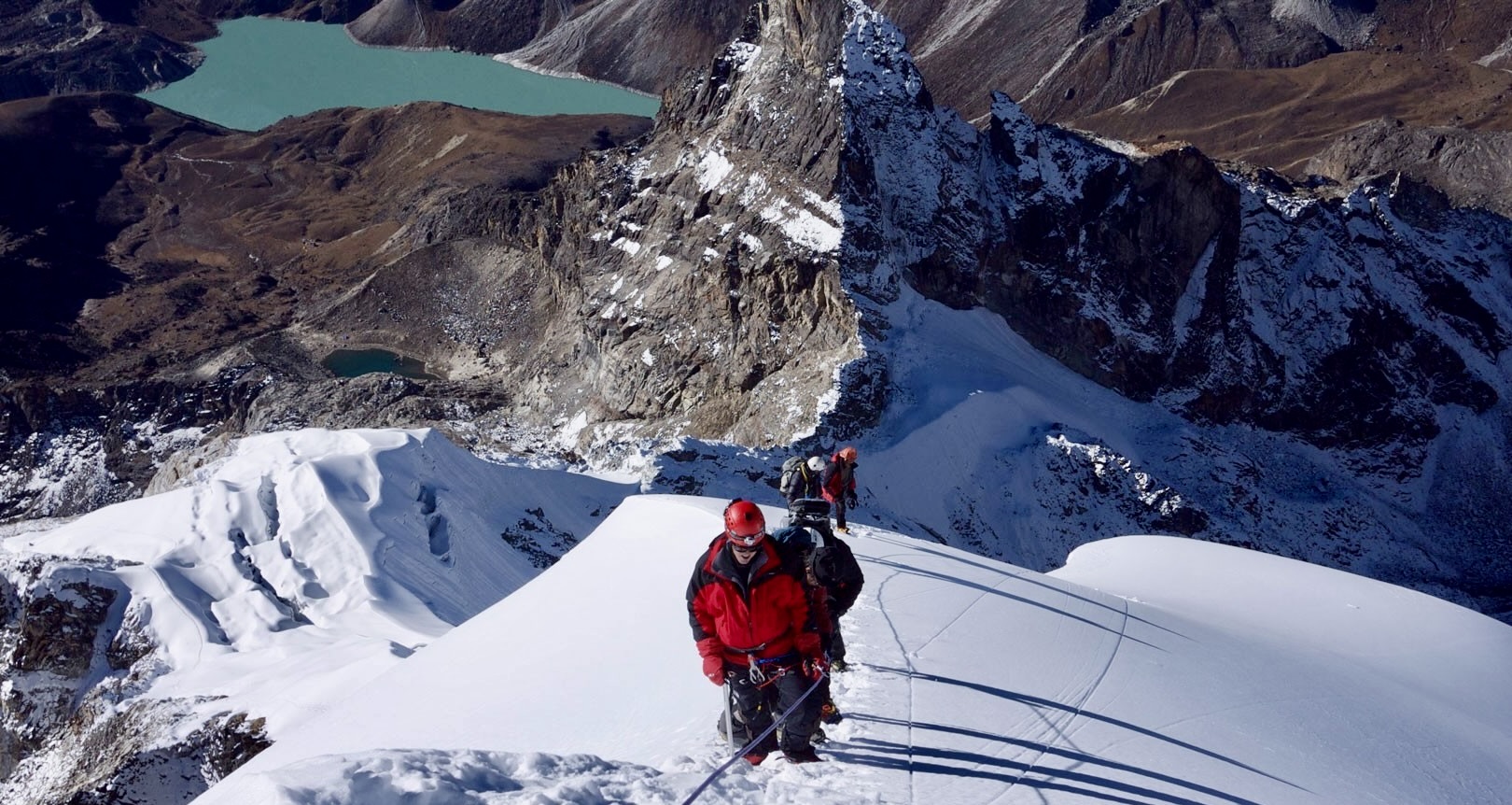
Key Features of Lobuche Peak Climbing
-
Ideal for Beginners: Lobuche East provides a relatively straightforward route, making it a suitable challenge for those new to high-altitude climbing.
-
Spectacular Everest Region Views: The summit offers magnificent views of Everest, Lhotse, Nuptse, Ama Dablam, and Pumori, amongst others.
-
Engaging Climbing Experience: While the climb is less technical, it includes enough challenges to engage and excite beginner climbers, such as crossing glaciers and navigating through crevasses.
-
Cultural Trekking Route: The approach to Lobuche involves trekking through the famous Everest Base Camp trail, providing a rich cultural experience as climbers pass through iconic Sherpa villages.
-
Skill Development: Lobuche Peak climbing is an excellent opportunity for beginners to learn and practice fundamental mountaineering skills in a high-altitude Himalayan environment.
-
Acclimatization and Safety: The climb is well-structured with acclimatization days, ensuring climbers adjust well to the altitude. Safety is further emphasized through experienced guidance and proper equipment.
-
Stunning Natural Beauty: The route to Lobuche is characterized by dramatic landscapes, including vast glaciers and rugged mountain terrain, offering an immersive experience in the heart of the Himalayas.
Why Choose Lobuche Peak for Beginners
- Balanced Challenge: It offers a perfect balance between a feasible challenge for beginners and the opportunity to experience high-altitude climbing.
- Exposure to High-Altitude Climbing: Ideal for those looking to experience what it's like to climb in the Everest region without extreme technical difficulties.
- Comprehensive Himalayan Experience: The expedition provides a holistic experience of Himalayan mountaineering, combining physical challenge, natural beauty, and cultural richness.
Lobuche Peak Climbing is an excellent choice for beginners looking to venture into the world of high-altitude climbing. It provides a manageable yet thrilling climb, set against the backdrop of the majestic Everest region. Luxury Holidays Nepal Pvt. Ltd. ensures a safe, enjoyable, and memorable climbing journey for all aspiring mountaineers.
Best Time to Attempt Peak Climbing in Nepal
The best time to attempt peak climbing in Nepal is typically during two main seasons: the pre-monsoon (spring) season and the post-monsoon (autumn) season. Each of these seasons offers distinct advantages for climbers:
Pre-Monsoon (Spring) Season (March to May)
- Weather: This period generally offers stable weather conditions, with progressively warmer temperatures as summer approaches.
- Visibility: The visibility is usually good, though there can be occasional haze.
- Climbing Conditions: The snow conditions are stable, making it safer for climbing. Glaciers and crevasses are typically well-covered.
- Advantage: Spring is a popular time for expeditions, especially to higher peaks like Everest. The routes are lively and well-traveled, which can be reassuring for less experienced climbers.
- Nature: The lower altitudes are in full bloom, particularly in the rhododendron forests, making treks to base camps scenically beautiful.
Post-Monsoon (Autumn) Season (September to November)
- Weather: Autumn is characterized by clear skies and stable weather, following the monsoon season. It's considered the best season for visibility and weather.
- Climbing Conditions: The post-monsoon period offers dry conditions with less snow on the mountains, which can be advantageous for technical climbs.
- Advantage: The trails and base camps are less crowded compared to the spring season, offering a more solitary experience.
- Nature: The landscapes are lush and vivid after the monsoon rains, with clear mountain views.
While these two periods are generally the best for peak climbing in Nepal, it's important to consider the specific mountain or route, as conditions can vary. High-altitude peaks might have different ideal windows for climbing. Moreover, global climate patterns can affect weather conditions, so it's always advisable to check recent weather trends and forecasts when planning an expedition.
The Top 7 Easiest Mountains to Climb in Nepal for Beginners offer an extraordinary opportunity for novices to experience the thrill and beauty of Himalayan mountaineering. Each mountain, from the iconic Mt Ama Dablam to the stunning Lobuche Peak, presents a unique blend of manageable challenges, breathtaking scenery, and rich cultural experiences. These climbs serve not only as an introduction to high-altitude trekking but also as a gateway to understanding and appreciating the majestic nature of the Himalayas. With the right preparation, guidance from tour operators like Luxury Holidays Nepal, and a spirit of adventure, even beginners can fulfill their dream of summiting a Himalayan peak, starting a journey that could transform their love for the mountains into a lifelong passion.
FAQs: Top 7 Easiest Mountains to Climb in Nepal for Beginners
Q: What makes these mountains suitable for beginners?
A: These mountains have been selected based on their non-technical routes, moderate altitudes, and relatively easier climbing conditions, making them suitable for beginners with basic fitness and determination.
Q: Do I need prior climbing experience?
A: Prior climbing experience is not mandatory, but basic trekking experience and good physical fitness are recommended. These climbs offer a chance to learn basic mountaineering skills.
Q: What is the best time of year to climb these peaks?
A: The best times are during the pre-monsoon (spring: March to May) and post-monsoon (autumn: September to November) seasons, offering stable weather and good visibility.
Q: How long does it typically take to climb these peaks?
A: The duration varies for each peak but typically ranges from 2 to 4 weeks, including acclimatization and the trek to and from the base camps.
Q: What kind of equipment do I need?
A: Essential equipment includes climbing boots, crampons, ice axes, ropes, and basic safety gear.
Q: What are the main risks associated with these climbs?
A: The main risks include altitude sickness, unpredictable weather, and icy terrain. However, risks are minimized with proper acclimatization, guidance, and following safety protocols.
Q: How do I prepare physically and mentally for these climbs?
A: Physical preparation includes cardiovascular fitness, strength training, and endurance exercises. Mentally, familiarize yourself with high-altitude conditions and be prepared for the challenges of mountain climbing.
If you need any further information, please contact us by email: at [email protected], Phone: at +977- 985 100 5129 (WhatsApp)

